#64 EIGHTY YEARS AGO TODAY--LEST WE FORGET
Trooper Clarence "Lightning" Homuth
Eighty years ago today, June 6, 1944, the Allies launched
Operation Overlord, the largest amphibious invasion in military history. The
landing on the Normandy beaches allowed the Allies to start taking back Europe
from Hitler.
The planning for D-Day was awesome. The Allies used massive deceptive operations (fake equipment, a phantom army, double agents, fraudulent radio transmissions, etc ) to mislead the Nazis about the main invasion target. On June 6th, more than 5000 ships and landing craft carrying troops and supplies left England while more than 11,000 aircraft were used to provide air cover and support the invasion. Paratroopers and glider troops were flown in behind the lines to secure bridges and exit roads. By day’s end about 156,000 Allied troops had landed on Normandy’s beaches; more than 4,000 troops were killed by the Germans defending the beaches, and many more soldiers were wounded or missing. Within a week, however, about 326,000 troops, more than 50,000 vehicles, and over 100,000 tons of equipment had landed and the beaches were secured. By August, all of northern France had been liberated and, by the spring of 1945, the Allies had defeated the Nazis.
Clarence Homuth, nicknamed “Lightning”, was born in 1921 in Teeswater, Bruce County. He was the youngest of six children of Albert and Bertha (McKague) Homuth and just a toddler when his father was killed in an unfortunate accident. Albert had recently sold his farm and purchased the Teeswater Flour Mill. Early one morning, he went to the mill, started the power, and when he found one of the spouts clogged, he crawled into the bin over the shafting. Somehow a large set screw on the shaft caught on the back of his coat and pulled him around the revolving shaft with terrific force. An employee happened by chance to be going fishing an hour before work and was passing by, but on hearing a strange pounding went into the mill, turned off the power, and then found Albert fast to the shafting. He cut his clothes with a knife and let him down. Both Albert’s feet were badly smashed where they had pounded against the ceiling and wall. The set screw had punched a painful hole in his back and there were ugly gashes in his legs. When discovered, he was unconscious, badly bruised and suffering from shock. There was initial hope that his injuries were not that serious, but unfortunately complications set in and he died a week later. He was survived by his wife, a daughter and five sons. His wife, Bertha, took in mending and cleaned other people’s homes and somehow made ends meet. She moved her family to Stratford where she found work as a seamer in a knitting mill. Like so many others, she lost her job during the Depression; it looks like the family had to rely on daughter Grace’s income as a private nurse; the younger brothers were in school.
World War II was declared in 1939 and the four oldest Homuth brothers immediately enlisted. Herbert became a Pilot Officer in the RCAF flying reconnaissance missions over Africa and India. Albert was a private in the Postal Corps delivering mail from home to war weary soldiers. (The volume of mail and soldiers constantly moving to different bases challenged the postal service but mail—hand-written, home-scented letters-- and packages like jams, tinned meats, coffee, tea—were necessary for morale.). Robert was a private in the ordinance corps and Carl was a corporal in the automotive corps. “Lightning” wasn’t about to be left behind so his big brothers lied for him and he was enlisted. (He was born in 1921 but his military records say 1920.) Clarence was a little guy; he was 5 feet 8 inches and weighed 123 pounds. I can only imagine Bertha’s feelings to have all five sons in uniform.
second letter to Herb and Jean
On June 6, 1944, the 6th Canadian Armoured Brigade was part of the D-Day assault. Its role was to support the infantry landing on the western half of Juno Beach. Six amphibious Duplex Drive (DDs) tanks were loaded on Landing Craft Tank (LCT) which had a special ramp for launching the tanks. At 7:15, the “down doors” bell rang and “B’ Squadron, including Clarence, launched their Sherman DDs into the choppy, white-capped sea about 4000 metres from the French shore. The sea-sick crews started off in first gear. The initial impetus carried them away from the LCTs and gave them the necessary time to lower propellers and change gears. Then the nineteen DD tanks headed for the beaches with each crew commander standing on the back of the deck steering towards Juno Beach. The rising tide brought waves over the top of the tanks and the water swamped some of the engines in a short time; meanwhile the troops were being fired at from German pillboxes and houses along the beach. The German defences were stronger than anticipated, especially in heavy calibre guns. The traffic and obstacles on the beach blocked the tanks’ movements. But 15 of the Squandron’s 19 tanks made it ashore ahead of the troops they were tasked to protect. From midday on, the beach was heavily pounded by artillery fire. B squadron, with Clarence, regrouped and then helped secure the beach.
DD Sherman tank with collapsible screen
Later that day, three groups of tanks from "B" Squadron were ordered to scout the high ground. Unfortunately, the radio net was down, so the tanks had to move ahead without support and return to report any enemy activity in the area. The tanks were told to cover as much ground as possible, destroy any resistance and then return. Clarence was the driver of one of the tanks. As "B" Squadron moved out, everything seemed okay. But soon heavy mortars opened up trying to hit the vulnerable top and rear armour of the Hussars’ Sherman tanks. The Germans also used a lot of smoke rounds to conceal themselves. A few miles inland, a German anti-tank gun was seen on the left flank, but the Hussars moved on keeping it covered. As this German gun (later proved to be a dummy) was absorbing the crew’s attention, a German 88mm tank concealed beside the road, suddenly opened fire and knocked out five tanks before it could be neutralized.
Trooper Homuth died instantly; six other Hussars also died in this ambush. Clarence's padre buried him on a little hill nearby and his best friend, Lloyd Pauli, later picked some poppies and put them on Lightning’s grave and fixed his cross for him. Pauli said of Clarence, “I was at the spot about an hour later, but there was nothing I could do as he had died instantly. All I can say is that his folks and friends should be proud of him. He went into battle fearlessly and unafraid, determined to do his part. He paid the supreme sacrifice.” Clarence was 23 years old. Twenty-one men from the First Hussars were killed in action on D-Day.
Clarence was later reinterred in the Beny-Sur-Mer Canadian Cemetery in Normandy. His name is on his parents’ gravestone in Wingham; his name is on the War Memorial in Stratford, Ontario; he is commemorated on Page 338 of the Second World War Book of Remembrance in Ottawa; there is a memorial brick dedicated to Clarence at the Juno Beach Centre in Courseulles-sur-Mer, France.
Beny-sur-Mer Commonwealth Cemetery
Juno Beach Centre, Normandy
1939-45 Star
France-Germany Star
The Defence Medal
War Medal
Canada Volunteer Service Medal with Clasp
Clarence Edward Homuth b. July 31, 1920 in Teeswater, Bruce Co., Ont d. Jun 6, 1944 in Basse-Normandie, France my second cousin 1x removed (Homuth line)
thanks to Bonnie Horton for the letters, personal photos and information

























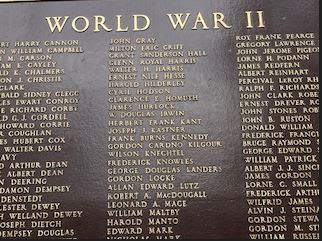







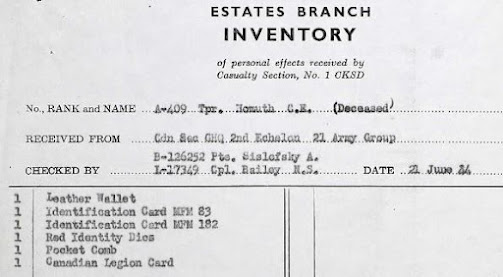
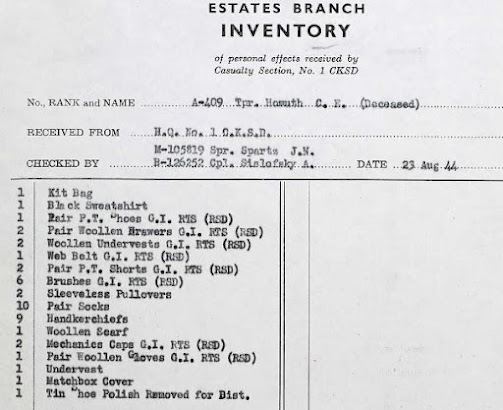
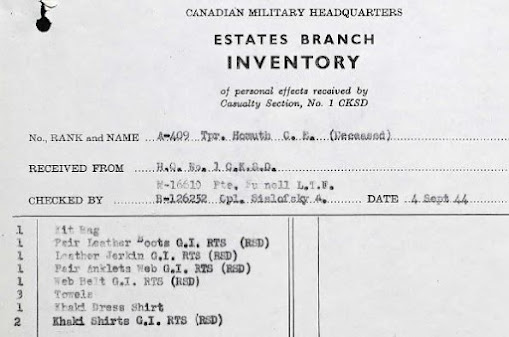







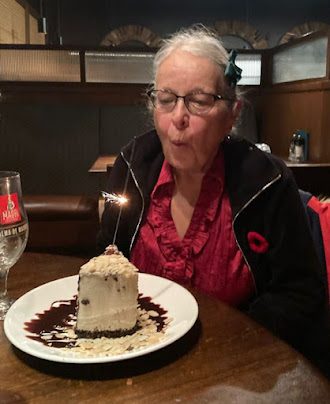

Beautifully written. The details make this a haunting story. He was so young and full of potential. But it’s a story often repeated. Thinking especially of the mother receiving that telegram ….
ReplyDeleteAn example of true courage by a great Canadian.
ReplyDeleteSo many young lives lost. He was an example of bravery in every sense of the word. Thank you for sharing.
ReplyDelete